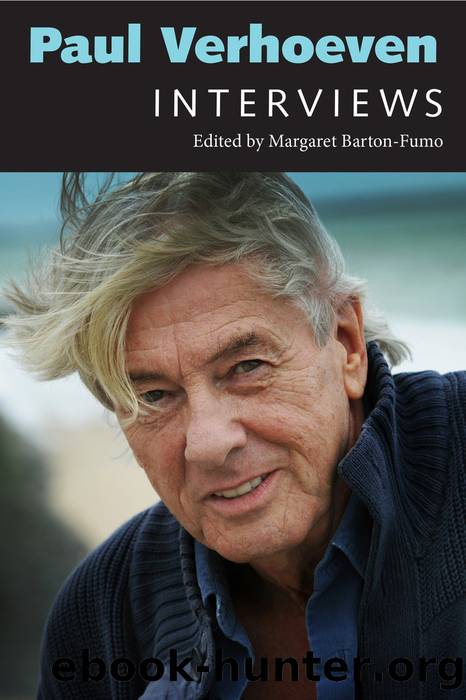Paul Verhoeven by Unknown

Author:Unknown
Language: eng
Format: epub
Publisher: University Press of Mississippi
Published: 2017-07-14T16:00:00+00:00
Showgirls: Shooting the Script
Paul Verhoeven / 1995
Excerpted from Showgirls: Portrait of a Film, Newmarket Press, 1995. Reprinted with permission by Paul Verhoeven.
Normally, when I direct a movie, I make detailed drawings of each scene of the script in sequence, indicating the type of shots, the angles, and the way in which I envision the shots being edited together. This process, called storyboarding, produces a sort of lengthy cartoon strip of the whole movie. I conceptualize visually, and the process of making these drawings helps me to think through every step in the making of a film. When I directed The Fourth Man, all of the storyboards were completed before we started shooting, and I have had the luxury of elaborate storyboards on all my American movies.
However, with Showgirls, we were rushed into production and there was no time to prepare storyboards in advance. I ended up making the drawings right in my script before the next day’s shooting on a day-to-day basis. What you see in these four sample pages is a sort of sketchbook, a visual diary of my thoughts about how this film should come together.
Actually, I am just as happy that I did not make my usual detailed preparations in this case. I think it might have been unnecessary and perhaps even hampering to be too precise and too clear from the beginning. I was working with a cast with many young actors I had not worked with before, and I was not sure how far I could push them in certain directions. So I tried to use my knowledge of the people who I was working with as I created the storyboards each day.
Day by day I felt better, because I could see how the actors worked together and how they looked through the lens, and I used that in the drawings. It was a kind of direct feedback that I never tried before. I could integrate my feelings about who they were and how they behaved into the drawings. Each night, before or after dinner, I sat down with my script and spent an hour or so creating the storyboards for the next day’s shooting. I truly came to enjoy the spontaneity that it allowed me to have.
Another advantage this daily exercise gave me was that I knew the locations of the sets I would be working on, so I had in my mind very clear images of where I would be shooting the actors. I knew what was possible and not possible. For example, I watched the carpenters building the sets for the Cheetah strip club because they were working in the studio next to me. I saw how they did it and I knew exactly where I needed my camera setups. I would know the lights already, more or less, and I would know where the poles for the pole dance were. The construction of the whole thing would be clear to me, so I could storyboard it carefully.
Sometimes, you prepare all your
Download
This site does not store any files on its server. We only index and link to content provided by other sites. Please contact the content providers to delete copyright contents if any and email us, we'll remove relevant links or contents immediately.
Call Me by Your Name by André Aciman(20357)
Ready Player One by Cline Ernest(14502)
How to Be a Bawse: A Guide to Conquering Life by Lilly Singh(7370)
Wiseguy by Nicholas Pileggi(5655)
The Kite Runner by Khaled Hosseini(5069)
On Writing A Memoir of the Craft by Stephen King(4851)
Audition by Ryu Murakami(4827)
The Crown by Robert Lacey(4715)
Call me by your name by Andre Aciman(4604)
Gerald's Game by Stephen King(4563)
Harry Potter and the Cursed Child: The Journey by Harry Potter Theatrical Productions(4433)
Dialogue by Robert McKee(4314)
The Perils of Being Moderately Famous by Soha Ali Khan(4159)
Dynamic Alignment Through Imagery by Eric Franklin(4105)
Apollo 8 by Jeffrey Kluger(3624)
Seriously... I'm Kidding by Ellen DeGeneres(3568)
The Inner Game of Tennis by W. Timothy Gallwey(3562)
How to be Champion: My Autobiography by Sarah Millican(3545)
Darker by E L James(3465)
